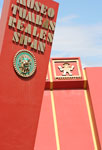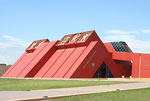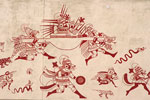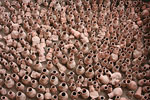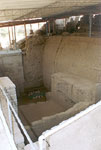Museo Tumbas Reales de Sipán
Museum of the Royal Tombs of Sipán
Location: Av. Juan Pablo Vizcardo y Guzman s/n. Lambayeque - 11 Km north of Chiclayo.
Attention: Tuesday to Sunday 9:00 AM. to 5:00 PM.
Telephone: (51 74) 283-978
Entrance: S/. 15 (US $ 4.5 aprox.), students S/. 7.50
As of August 9th, 2003, Peru, Lambayeque and Chiclayo has a new museum. The Royal Tombs of Sipán exhibits the most important archaeological remains of the Mochica Culture, in an exceptional exhibition that combines maximum scientific accuracy, security and enjoyment to show the jewels, emblems and ornaments found in 1987 in the tomb of a Mochica government leader called the Lord of Sipán.
The Museum of the Royal Tombs of Sipán has its origin in a project of organized archaeological rescue in April of 1987, when a small team of Peruvian archaeologists we assumed the responsibility to save and to investigate the archaeological sanctuary of Sipán, as opposed to its violent sacking and destruction, a tragic destiny that permanently threatens and affects the cultural patrimony of Peru.
Our intervention began under the difficult circumstances of a police intervention and with limited resources offered by institutions and identified companies the culture. Few months later, the exhaustive work of field allowed to the scientific recovery of the call Tomb of Lord of Sipán, the first intact funeral context of a governor of the Old Peru that showed the today world all the magnificence and an invaluable information on the development level, organization and religious thought of the Moche or Mochicas, one of the most important cultures pre Incas.
From the first moments, our archaeological rescue was the delicate problem as opposed to investigate, to conserve, to recover and to think about the definitive destiny of the valuable discovery that immediately was considered between the great events of American archaeology.
After the impact and enthusiasm of the discovery the responsibility came to preserve this important cultural treasure of Peru for the future generations, as well as to suitably present / display it with dignity and to the world, is to say to conserve and to recover each one of the archaeological pieces affected by the time and to plan previously its location and definitive destiny.
The first step that meant to develop to optimal techniques of registry and recovery in the field, was solved by our equipment. The second task forced to us to ask for the support of the international community to assume the restoration of the metallic objects front to our limitations of laboratories and resources. The support of Germany and Spain allowed to save the urgency of these works and to install a laboratory in our country. That evidently most difficult of all the responsibilities as opposed to the magnitude of the archaeological discovery it constituted his conservation and definitive presentation in a worthy atmosphere that reunites to the best specifications and museum qualities.
From the beginnings we thought about an own space that it was maturing and progressing from the project of an additional room to the Brüning Museum, in Lambayeque, to an annexed building, finally to force us to the challenge of a great building which it combines an original architecture and of Peruvian personality with a museum that exposes didactically with all securities and one of the most important pages of the history of ancient Peru, necessary to sustain the identity of the Peruvians of today, to promote our cultural inheritance and to become a center of cultural and tourist interest that impels the development of the region.
The challenge which we assumed with the generous participation of architect Celso Prado was to conceive a majestic Museum like our past, creative, safe and functional to conserve and to present / display with dignity the Royal Tombs of Sipán understood like a unit of ornaments, emblems and offerings that accompanied to our old governors in their trip the eternity.
This museum would have to thus constitute in a Museum-Mausoleum and sanctuary of our culture. The international institutions, companies, organisms and friends are many who have supported to us. Thanks to them we have reunited the basic resources to initiate this work that was endorsed by the Peruvian Government.
The innumerable difficulties were overcome by the unshakeable will of our equipment. The Museum is finished and, to name of all we, only it fits the immense satisfaction of having fulfilled in front of to the country and the memory of our ancestors.
The modern and majestic of the Royal Tombs of Sipán Museum opened with a dramatization of the life of the Lord of Sipán and his royal court. The three-floor center was built with a US $ 5 million investment. It is formed in a pyramid, inspired by the Mochica sanctuaries, to thus bring together the past, present and future of the Lambayeque identity..
ll the exhibits are original pieces and each has been carefully cleaned and restored to the minutest detail. The leading representative of the Mochica culture, the Lord of Sipán, considered to be the most important governor of ancient Peru some 1700 years ago, is to be buried in this architectural jewel.
As a living example of the main productive activities of the Mochica culture, a handcraft village is to open at the Center for Sipán Tourism-Artisan Innovation Technology. The center is within the Royal Tombs of Sipán Museum complex and is made up of four original artisan workshops: gold and silversmiths, pottery, weaving, medicinal plants and shamanism.
By: Dr Walter Alva - Director of The Royal Tombs of Sipán Museum
The Lord of Sipán
He was a very important Mochican warrior priest, which remains were founded in Huaca Rajada by Dr. Walter Alva in 1987.
In his tomb were discovered a great quantity of gold and silver objects, jewels, ceramics and carved wood of incredible value. This investigation had given archaeologists the chance to know many more aspects of the Mochican Culture.
In the main tomb was found a guard, skeleton of a young man with a golden shield and sectioned feet.
"El Señor de Sipán" (The Lord of Sipan), was founded in a sarcophagus made of wood (this is the first event founded in America), next to his head were the skeleton of two young women, and at his sides a skeleton of a dog and two lamas.
He was all covered with gold, silver and copper, chest protector with jewels and gold necklaces. His skull rested on a big golden plate.
Very close to this tomb, in 1989, some investigators of the Brüning Museum discovered the tombs of "El Sacerdote" (The Priest), and the tomb of "El Viejo Señor de Sipán" (The Old Lord of Sipan).
The tomb of the "Viejo Señor de Sipán" (Old Lord of Sipan) is chronologically older, and with difference among the others, was found a sarcophagus without company and wrapped in vegetal fiber. It had signs of royal importance, dressed with gold scepter, fine gold and silver jewels, chest protectors made with pearl shells, peculiar and unique pictures.
The archaeological investigation continue, and the last discovery was found in 2007, named the funeral chamber 14
All the original pieces were restored in Germany at the Mainz Museum (1988-1993) and are actually shown at the Museum of the Royal Tombs of Sipán in Lambayeque. Besides, all the replicas from the originals are used as demonstration in Huaca Rajada.
Sipán Photo Gallery:
- Huaca Rajada and Tombs of Lord of Sipán
- Royal Tombs of Sipán Museum Photo Gallery 1
- Royal Tombs of Sipán Museum Photo Gallery 2
